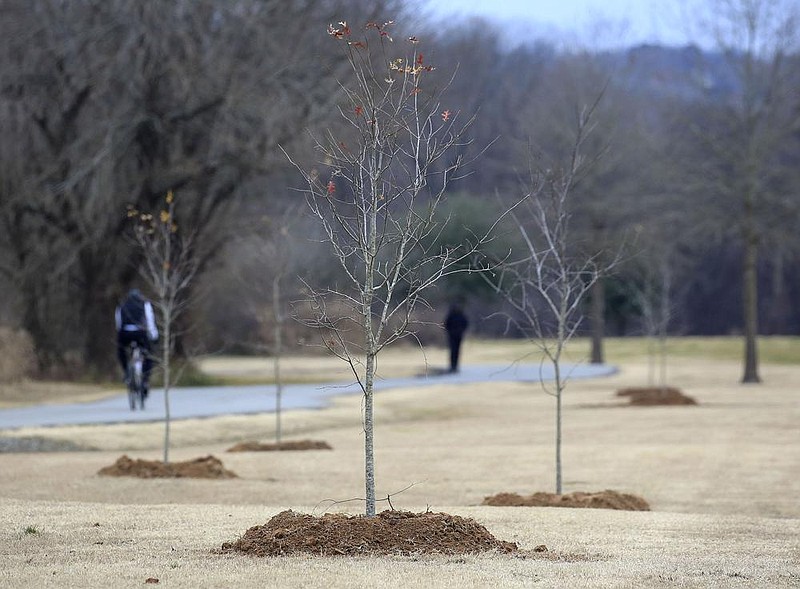North Little Rock's Burns Park is seeing an influx of new trees as the city replaces ones that have been damaged by Arkansas River flooding in recent years and adds additional trees as part of its greenscape project.
Thirteen red oak trees of various varieties were planted along the River Trail west of the park's soccer complex this week as part of the Parks and Recreation Department's efforts to replace trees that were damaged by flooding over the past couple of years.
Shara Brazear, a spokeswoman for the city of North Little Rock, said the department planted 30-gallon trees along the River Trail. The trees were donated to the city from Bemis Tree Farm.
"We chose Bemis Tree Farms because they grow their own trees and they are a little heartier," she said. "They are 6 to 7 feet tall and a couple inches in diameter."
Widespread flooding along the Arkansas River in the spring of 2019 caused about $2 million in damage to North Little Rock's parks and riverfront areas.
Flooding began May 27, 2019, with the river cresting at 29.7 feet June 5. By that time, much of Burns Park's facilities south of Interstate 40 were under water, including its 17 soccer fields, the golf course, the dog park and the River Trail.
Along the downtown riverfront, which is also under Parks Department management, water covered the parking lots inside the flood wall, reaching up to 4 feet high along the wall. Pedestrian and vehicular openings in the sea wall had to be gated off from the public as safety precautions.
Park ranger Ian Hope said Burns Park lost about 15 trees along the River Trail because of the flood.
"We waited as long as we could to see if they would recover, but they were just under water too long," Hope said. "We had four of them that survived, which is amazing, and we have four more spaces left open.
"Unfortunately if there is another flood, then we are back to the drawing board."
Hope said an additional 10 trees will be planted around the youth baseball complex at Burns Park, but those trees are part of the city's green ordinance plan.
The city has a minimum requirement for the number of trees a business must plant in order to expand, depending on the size of the business and the amount of construction.
Hope said a local business wasn't able to comply with the required trees ordinance because of spacing issues, but it donated money to the city that allowed the city to buy the 10 trees that will be planted at the youth baseball complex in Burns Park.
"These will replace some trees that have died over time," Hope said. "We have picked out the trees and Bemis Tree Farm will install them. We hope to have them installed in the next couple of weeks."
North Little Rock's tree canopy provides an estimated $3.9 million in air quality services each year, $1.1 million in carbon storage and sequestration benefits and $78 million in total stormwater management savings, according to the city's most recent Plan-It Geo study conducted in 2013.
The urban tree canopy study encompassed 35,252 acres. Based on the study, the city has 11,913 acres of urban tree canopy, 13,696 acres of possible planting area -- defined as nonroad, nonbuilding land area where it is physically possible to plant trees -- and 9,643 acres that are considered unsuitable for tree planting.
The city's zoning ordinance requires that a landscape plan be included with all building permits, plats, site plan reviews, rezoning, conditional and special-use permits.
The ordinance also requires newly constructed buildings to have one tree per six parking spaces for shade.

